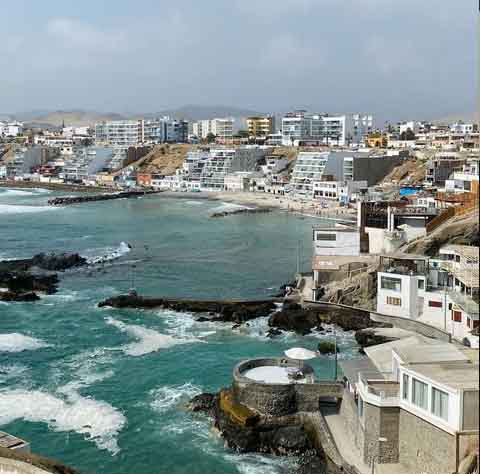
I have always enjoyed traveling and having experience with different cultures and different people. But it’s also a wonderful thing to be able to benefit and enable research, not only in my country but around the world. Lima Peru is a city in Peru with extreme and fascinating attractions that needs to be brought to book,hence these top tourist attractions in Lima Peru.
Lima, the capital of Peru lies on the arid Pacific coast of the country. Though its colonial center is preserved, it is a crowded metropolis and one of South America’s largest cities.
What is Peru Lima known for?
Lima offers an exceptional scope of feelings, sensations, varieties and flavors to explorers that visit the city’s cathedral, fly over the sea and partake in a beautiful and attractive dusk with unrivaled cooking.
Lima is a city filled with lots of movements created by its people and their living culture, where you will observe each edge of Peru addressed.
Most future travelers to the city keep asking Is Lima Peru a rich or poor city? The answer is that the area has high development index that enjoy relatively low poverty as a result of economic opportunity. Peru is one of the countries in the world that has seen the fastest reduction of poverty, partly due to sound economic policy and growth.
The various tourist sites and attractions make the city worth visiting and some of the top attractions to explore in the city of Lima in Peru include the list compiled.
Recommended… Plan your Peru trip and bookings here
26 Best Tourist Attractions in Lima Peru
1. Larco Museum
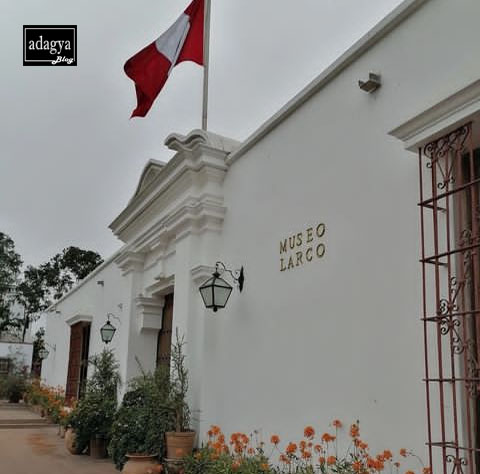
The Larco Museum is a privately owned museum of pre-Columbian art, located in the Pueblo Libre District of Lima Peru. The museum is housed in an 18th-century vice-royal building. It showcases chronological galleries that provide a thorough overview of 5,000 years of Peruvian pre-Columbian history.
How much does it cost to go to the Larco Museum?
Generally, the entrance fee to the Larco Museum is a small amount of coin in the Peru currency which varies with adults, students and under age but free for children who are below the age of Eight (8).
What kind of art is in the Larco Museum?
The Larco Museum which was recognized as the best the museum in South America between the 2017 to 2018, is on the mission of developing ancient cultures and make it understandable to tourists and travelers. Among the kind of arts in the Larco Museum include gold and jewelry, ceramic statuary and sculptures, metals, textiles, and a display of erotic representations of the ancient world
Where is the Larco Museum?
Larco Museum is in Lima located at the Av. Simón Bolivar 1515, Pueblo Libre 15084 of Peru.
2. Plaza De Armas De Lima
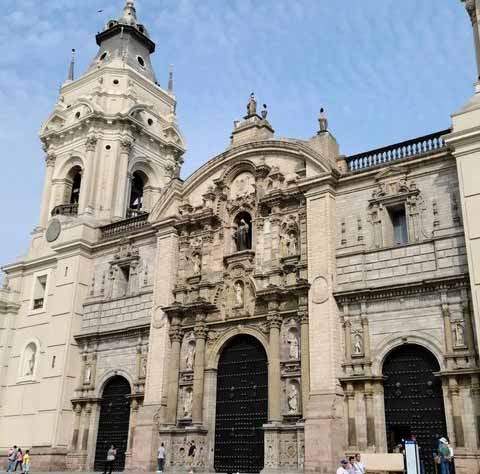
Plaza de Armas de Lima also known as The Plaza Mayor de Lima, is the birthplace of the city of Lima, as well as the core of the city. Located in the Historic Centre of Lima, it is surrounded by the Government Palace, Lima Metropolitan Cathedral, Archbishop’s Palace of Lima, the Municipal Palace, and the Palacio de la Unión.
It is one the tourist attractions in Lima Peru that is free for travelers.
3. Huaca pucllana
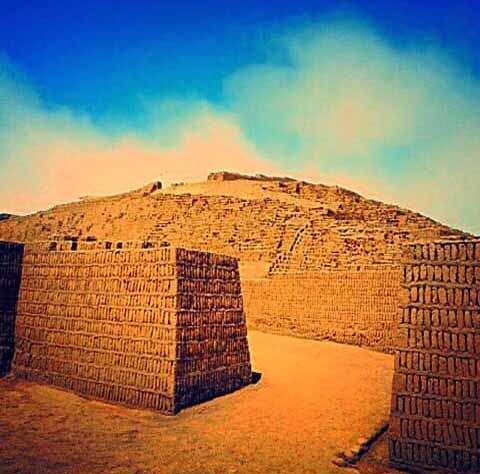
Huaca Pucllana or Huaca Juliana is a great adobe and clay pyramid located in the Miraflores district of central Lima, Peru, built from seven staggered platforms.
It can be located in Lima’s Miraflores district and it is one of the most important ceremonial centers of Lima Culture, which dates back to A.D. 500-700. The Huaca Pucllana was built by the Lima culture, which inhabited central Peru between 200 and 700 AD, nestled between the Moche culture to the north and the Nazca culture to the south. It is has an amazing archaeological sites and architectural buildings relating to the Peruvian race.
4. Convento De San Francisco

The San Francisco Convent is one of the most visited and famous tourist attractions in Lima. The land for the Convent was given to the Franciscan Order by Pizarro when the city was founded in 1535. You have to take the tour (in English or Spanish) in order to gain access to the area, but it’s an interesting one.
The main attractions are hand-painted tiles from Seville, the cusqueña art movement and the Last Supper painting with elements from the Peruvian culture. The Library is also quite amazing, with thousands of rare books, beautifully displayed, such as the first Spanish dictionary and one edition of the Bible printed in Holland in 1570.
You will also learn more about the religious history of Peru, the Peruvian Saints, Religious Art, but nothing is more famous – and chilling – than the catacombs, where over 25,000 bones were discovered from the Colonial period burials. The church, which is a classic example of the Peruvian Baroque architecture, is still in operation and sought by local pilgrims.
5. The Cathedral of Lima
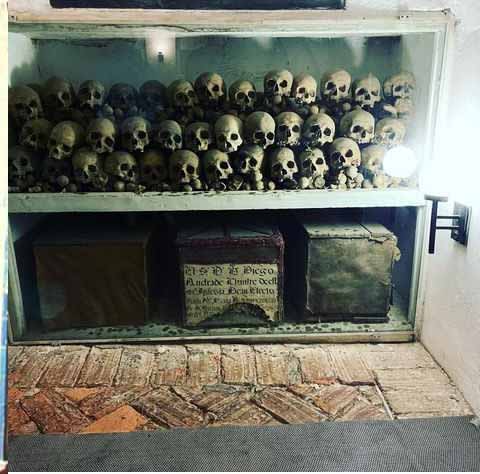
The Cathedral of Lima in the city’s historic center is the Lima’s most iconic building and home to the best museum of religious art. It is also known for being home to the tomb of Spanish conquistador, Francisco Pizarro. The Cathedral of Lima is located on the east side of the Plaza de Armas in downtown Lima.
The main church of Peru dates back to 1535, when Francisco Pizarro first laid the foundation for the church which would serve the new Spanish colonists. The temple was inaugurated in 1540 and elevated to the status of cathedral in 1541 when the Lima diocese was formed.
The first Archbishop of Lima expanded the original temple in 1551, but it did not get a carved-stone façade until 1649. It was consecrated as a basilica in 1625. The 1746 Lima earthquake destroyed the church, requiring a rebuilding effort from scratch which was not completed until 1778. There was an earthquake, hence another renovation in the 19th century.
The Cathedral of Lima was visited by four saints of the colonial era including Santa Rosa de Lima, San Martin de Porres, San Juan Macias and San Francisco Solano. In 1985 Pope John Paul II visited in a historic first, and he returned in 1988. With all the phases of construction led to a mix of architectural styles, as in most of Lima, including neoclassical, baroque and gothic.
The left of the Cathedral is the Archbishop’s Palace, recognized by the wooden balconies, an architectural icon of Lima. The front façade of the Cathedral features sculptures of Jesus and the apostles, as well as the coat of arms of Peru. Inside, 14 chapels line each wall of the sanctuary. The first one immediately after the main entrance, which you do not have to pay the museum admission fee to visit, contains the tomb of Spanish conquistador Francisco Pizarro.
Inside the museum of the cathedral is the galleries mostly feature religious paintings and sculptures. Near the rear to the left from the main entrance, the museum of religious art opened in the 1970s. In the basement is a crypt. While not as sensational as the catacombs of San Francisco, those with children be warned that there are skulls on display. The sanctuary’s gold-plated altar is flanked by dozens of wooden choir stalls with carvings of saints and religious leaders.
Entry into the museum cost a small amount of money.
6. Parque del Amor (Love Park)
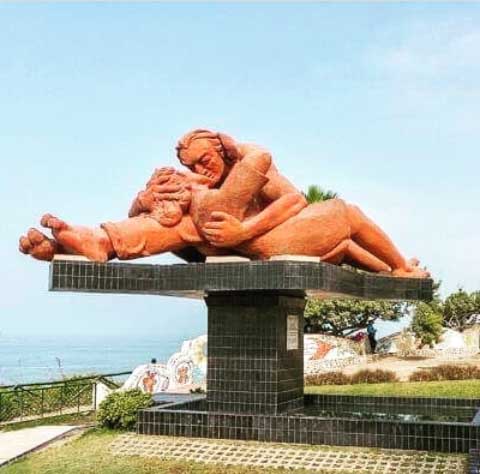
Parque del Amor in Miraflores is located following the Malecon de la Reserva after the bridge at the intersection with Malecon Balta. This small park is entirely dedicated to all lovers and offers a stunning view of the bay of Lima. It’s really romantic here at sunrise and sunset.
The surrounding walls are artfully decorated with mosaics. In the center of Parque del Amor you find the statue “El Beso” (The Kiss) from Victor Delfín. It shows two lovers united in an intimate kiss.
7. Miraflores
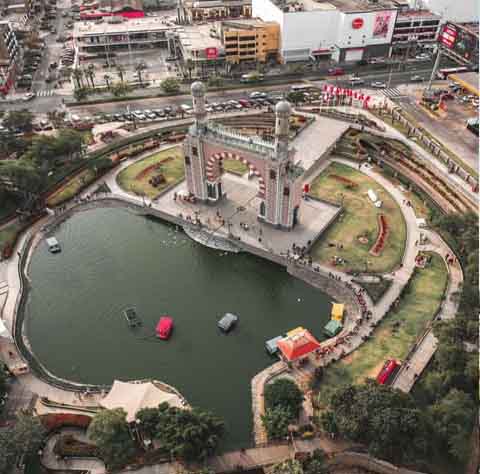
Miraflores is a district of the Lima Province in Peru. It is an exclusive residential and upscale shopping district south of downtown Lima. It is also one of the most affluent districts that make up the city of Lima. It has various hotels (including the Hilton, the JW Marriott, and the Belmond), restaurants, bars, nightclubs, and department stores. Miraflores is one of the main tourist attractions in Lima.
8. Museo de la Nacion (National Museum)

The Museo de la Nación (English: Museum of the Nation) is one of two major museums of Peruvian history in Lima, Peru. It is much larger than the other main museum in Lima, the Peruvian National Museum of Archaeology, Anthropology, and History. Currently it is no longer being used as a museum, carrying only very esporadical exhibitions.
The Museum of the Nation housed thousands of artifacts spanning the entire span of human occupation in Peru, including an impressive collection of Moche, Nazca, and Wari ceramics. The museum also houses reproductions of many famous ancient Andean artifacts, most notably the Lanzón from Chavín de Huantar ; a recreation of the burial chamber of the Lord of Sipan and the famous Revolt of the Objects Mural.
It is now serving as the office of the Ministry of Culture.
9. Santo Domingo

One of Lima’s most historic religious sites, the Iglesia de Santo Domingo and its expansive convent are built on land granted to the Dominican friar Vicente de Valverde, who accompanied Pizarro throughout the conquest and was instrumental in persuading him to execute the captured Inca Atahualpa. Originally completed in the 16th century, this impressive pink church has been rebuilt and remodeled at various points since.
It is most renowned as the final resting place for three important Peruvian saints: San Juan Macías, Santa Rosa de Lima and San Martín de Porres (the continent’s first black saint). The convent – a sprawling courtyard-studded complex lined with baroque paintings and clad in vintage Spanish tiles – contains the saints’ tombs. The church, however, has the most interesting relics: the skulls of San Martín and Santa Rosa, encased in glass, in a shrine to the right of the main altar.
10. Las Nazarenas
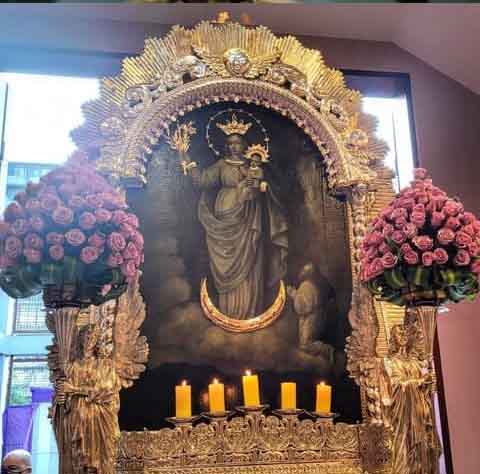
One of Lima’s most storied churches was part of a 17th-century shantytown inhabited by former slaves. One of them painted an image of the Crucifixion on a wall here. It survived the devastating earthquake of 1655 and a church was built around it (the painting serves as the centerpiece of the main altar) in the 1700s.
The church has been rebuilt many times since but the wall endures. On October 18 each year, a representation of the mural known as ‘El Señor de los Milagros’ is carried around in a tens-of-thousands-strong procession that lasts for days.
11. Barranco

Barranco is one of 43 districts in Lima, Peru. Its current mayor is José Juan Rodríguez Cárdenas. The district is considered to be the city’s most romantic and bohemian, being the home and working place of many of Peru’s leading artists, musicians, designers and photographers.
12. Circuito Magico Del Agua ( Magic Water Circuit)
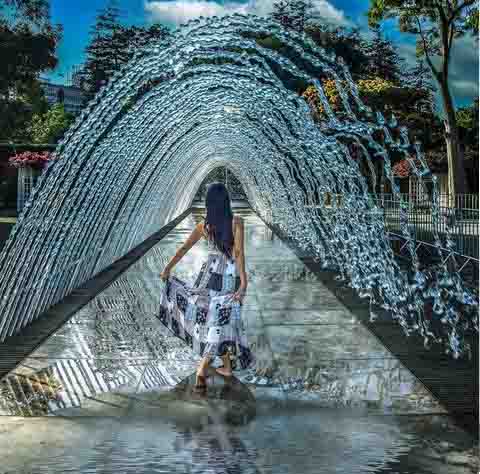
Lima’s Circuito Mágico del Agua (Magic Water Circuit) opened in 2007 after a hefty investment of US$13 million. Built within the Parque de la Reseva, a historic 19-acre (eight hectare) park, the series of 13 illuminated fountains has since proved a successful addition to Lima’s many attractions.
13. Pachacámac

Pachacámac is an archaeological site 40 kilometres southeast of Lima Peru in the Valley of the Lurín River. The site was first settled around A.D. 200 and was named after the “Earth Maker” creator god Pacha Kamaq. The site flourished for about 1,300 years until the Spanish invaded. Pachacamac covers about 600 hectares of land.
14. Historical center of lima

It is the old downtown of Lima metropolis, it is normally known as El Damero de Francisco Pizarro—checkerboard of Francis, because of its design in a military quadratic shape; it all starts in the Plaza de Armas of Lima, which is the birthplace of the city.
15. Indian Market – Centro Artesanal Miraflores

Indian Market – Centro Artesanal Miraflores is a market in Lima described as the largest handicraft hub. It opens daily from 9 AM to 6 PM. Visitors are greeted with bright murals surrounding the gate that leads to the Indian Market.
Inside are stalls that are filled with rugs, pottery, toys, statues, clothing and other souvenirs of all prices and sizes. Each stall offers something unique to tourists who want to take a piece of Peru back home with them.
Explore the market for beautiful locally crafted items from the market in Lima Peru.
16. San Bartolo beach

San Bartolo is located south of Lima, the capital of Peru. It is called a family beach, because the water here is calm due to the stone breaks that protect the coast from the steep waves.
San Bartolo has different beach areas. Surfers will love Ribera Norte and El Peñascal, both with good, big waves: in fact, some official international competitions have been hosted here. On the other hand, Ribera Sur beach is a quiet and safe beach, perfect for swimming and for other nautic sports, as well as for relaxing. And there’s the possibility of practicing motocross on the hills nearby the town.
17. Casa de Aliaga Historic House, Lima

La Casa de Aliaga is a colonial-style building located in the historic center of Lima. The building would have been built on a huaca . The building dates from May 1536 at the beginning of the founding of the city. It belonged to Don Jerónimo de Aliaga y Ramírez . It was destroyed by the Lima Earthquake of 1746 and rebuilt by Juan José Aliaga y Sotomayor. In the 19th century a series of works were carried out.
The original construction was made with quincha and adobe. The architecture is eclectic in style due to various changes made since its construction. The styles present are Renaissance, Mannerist, Baroque or Neoclassical . It has 18 rooms and property at the time.
18. Marcahuasi
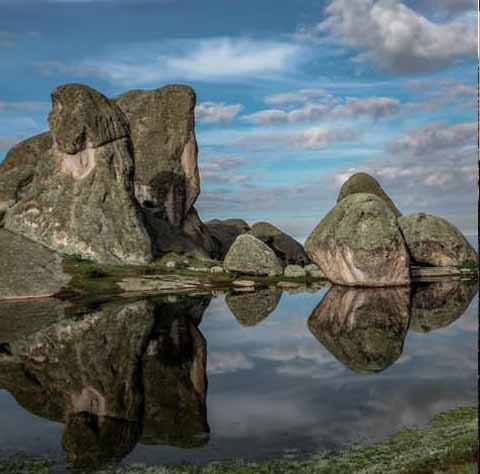
Marcahuasi is a plateau in the Andes Mountains, located 60 km east of Lima, on the mountain range that rises to the right bank of the Rímac River. This mountain range dominates the landscape at 4,000 metres (13,000 ft) above sea level and the place is known for curious shapes of human faces and animals visible in granite rock.
19. Presidential Palace (Palacio de Gobierno)
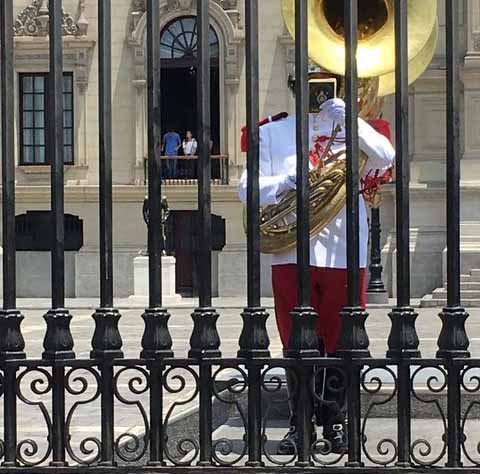
The Government Palace also known as the House of Pizarro, is the seat of the executive branch of the Peruvian Government, and the official residence of the President of Peru. The palace is a stately government building, occupying the northern side of the Plaza Mayor in Peru’s capital city, Lima.
Set on the Rímac River, the palace occupies the site of a very large revered object that incorporated a shrine to indigenous governor of Lima.
20. Barrio chino
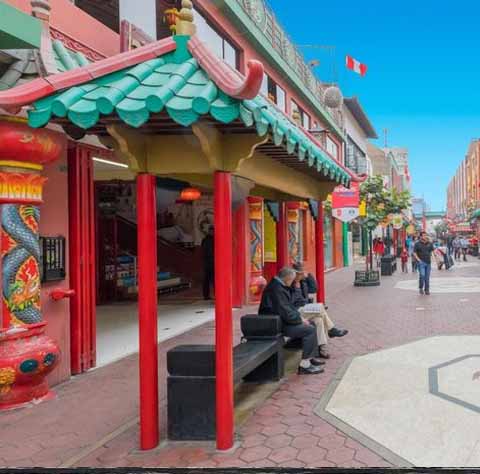
Barrio chino is a neighborhood in Lima, Peru that is centered on two blocks 7 and 8 of Ucayali Street in downtown. The neighborhood was founded in the mid-19th century by Chinese immigrants, but it was heavily damaged in the late 19th century by the War of the Pacific and further declined in the following decades. It experienced a revival starting in the 1970s and is now a thriving resource for Chinese-Peruvian culture.
21. Museo MATE
Mario Testino Museum is a non-profit organization founded by Peruvian fashion photographer Mario Testino, in 2012. It’s a platform for the development of creative industries, a window for the international contemporary art in Lima and for peruvian talent to the world.
22. Las Lomas de Lúcumo
Las Lomas de Lúcumo is an ecosystem in Pachacamac closer to Lima. It is an ideal for practicing adventure sports or outdoor activities. The Lomas de Lucumo has coastal hills that in winter (June to November) due to the effect of the accumulation of mist, are filled with greenery and life for hiking.
23. Caral Perú
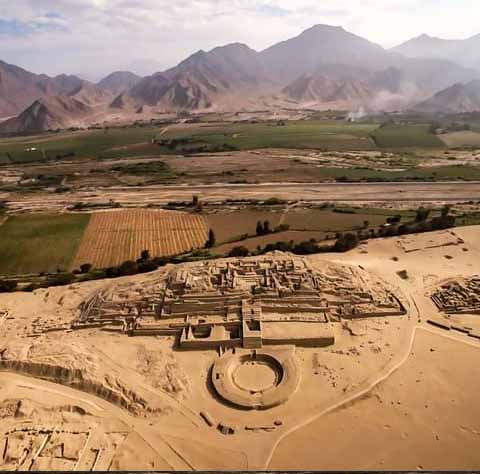
Caral is the origin of Andean culture. More than five thousand years old, Caral developed at the same time as other great cultures in Mesopotamia, Egypt and China.
This sacred city is situated in the middle of the Supe Valley, amid fertile lands close to the sea, and was inhabited by skilled fishermen, farmers and expert seafarers. Among its many mud brick structures and circular plazas, six main pyramids once stood.
It is now a World Heritage Site, Caral was an imposing urban center, and its farming techniques and sustainable practices remain a reference point to this day.
24. Parque El Olivar
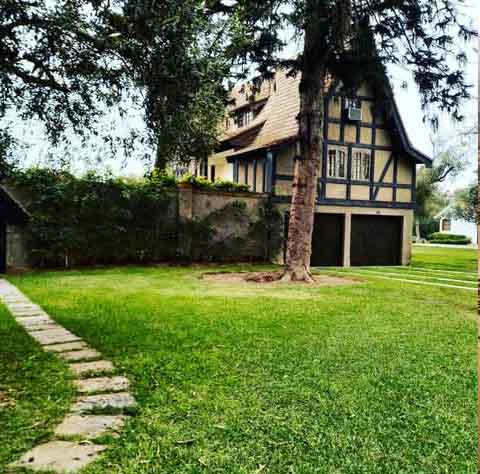
El Olivar Park is a beautiful forest-type park in the heart of the San Isidro financial district, populated with more than 1,500 olive trees.
This park dates back to the colonial period, a time when houses began to be built around the park, so today we can find mansions that over the years and in a moderate Lima, still have an architecture of that time.
El Olivar Park was declared a National Monument in 1959 in Lima Peru for the ancient past of the forest, hence a major tourist attraction.
25. Museo Textil Precolombino
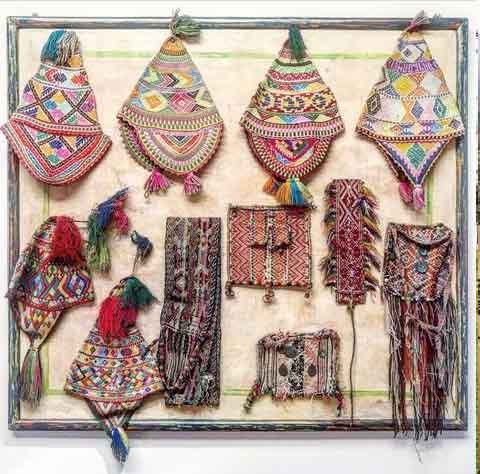
The Amano Museum of Pre-Columbian Textiles is one of Peru’s oldest institutions dedicated to protecting the country’s textile heritage. Since its foundation 52 years ago, the museum has shared one of the most complete collections of pre-Columbian textiles, which spans cultures including Chavin, Paracas, Moche, Nazca, Wari, Lambayeque, Chimu and Inca.
26. Parque de las Leyendas (Zoo)
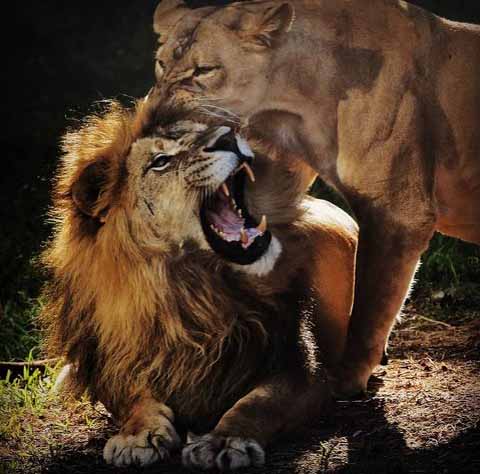
Parque de las Leyendas (Park of Legends), is Lima’s zoo located in the western district of San Miguel, just before Callao if coming from the city center or the southern districts of Lima.
The Parque de las Leyendas zoo has over 215 species among mammals, birds, reptiles, amphibians, fish and insects. The most important species are the giraffe, lion, tiger, hippopotamus, zebra, baboon, buffalo, grizzly bear, black bear, peacock, silver fox, chimpanzee, ostrich, water buffalo and turtle from Galapagos.
There are also species that belong to the Andean zone of Peru are here. There are 118 kinds of mammals and 93 kinds of birds. Among the most important ones we have Eagle, Royal owl, Condor, kestrel, swan, criollo duck, chinchilla, guanaco, oso de anteojos, vicuña, alpaca, llama, Andean fox, Andean puma, donkey, deer and sheep.
The rest of the species are those that belong to the Peruvian Amazonia such as Anaconda, Otorongo, Sajino, jaguar, tapir, papagayo (parrot), Lion monkey, titi monkey, macaw, water otter, white winged turkey, brown jaw Tuca neta, cock of the rock, spider monkey, ocelot, majas, two fingered perezoso bear, yellow tailed choro monkey.
Also read about… Best Tourist Sites To Visit In Ghana
Thank you for reading about the various tourist attractions in Lima Peru.
Kindly follow our social media handles and let’s get interactive.
Related articles
The Top Things To Do And See In Harare Zimbabwe
Travel Guide And Things To Do At The Victoria Falls
Meet The Beautiful Tanzania People From The Various Tribes
Things To Know About Nigeria Culture
Interesting Facts You Need To Know About Tanzania In Africa
Kenya Tourism: 16 Top Attractions To Visit
